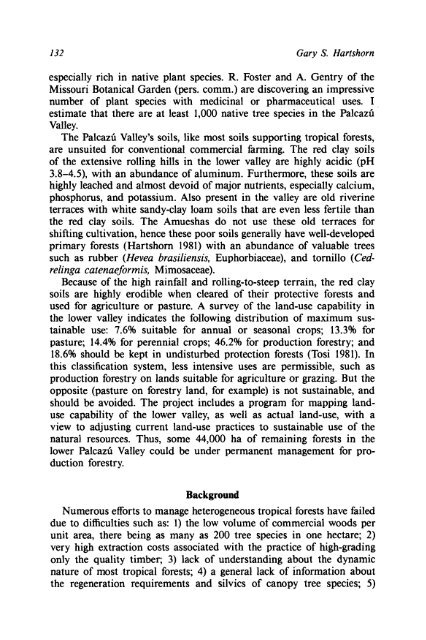Fragile Lands of Latin America Strategies for ... - PART - USAID
Fragile Lands of Latin America Strategies for ... - PART - USAID
Fragile Lands of Latin America Strategies for ... - PART - USAID
Create successful ePaper yourself
Turn your PDF publications into a flip-book with our unique Google optimized e-Paper software.
132 Gary S. Hartshorn<br />
especially rich in native plant species. R. Foster and A. Gentry <strong>of</strong> the<br />
Missouri Botanical Garden (pers. comm.) are discovering an impressive<br />
number <strong>of</strong> plant species with medicinal or pharmaceutical uses. I<br />
estimate that there are at least 1,000 native tree species in the Palcazii<br />
Valley.<br />
The Palcazii Valley's soils, like most soils supporting tropical <strong>for</strong>ests,<br />
are unsuited <strong>for</strong> conventional commercial farming. The red clay soils<br />
<strong>of</strong> the extensive rolling hills in the lower valley are highly acidic (pH<br />
3.8-4.5), with an abundance <strong>of</strong> aluminum. Furthermore, these soils are<br />
highly leached and almost devoid <strong>of</strong> major nutrients, especially calcium,<br />
phosphorus, and potassium. Also present in the valley are old riverine<br />
terraces with white sandy-clay loam soils that are even less fertile than<br />
the red clay soils. The Amueshas do not use these old terraces <strong>for</strong><br />
shifting cultivation, hence these poor soils generally have well-developed<br />
primary <strong>for</strong>ests (Hartshorn 1981) with an abundance <strong>of</strong> valuable trees<br />
such as rubber (Hevea brasiliensis, Euphorbiaceae), and tornillo (Ced-<br />
relinga catenae<strong>for</strong>mis, Mimosaceae).<br />
Because <strong>of</strong> the high rainfall and rolling-to-steep terrain, the red clay<br />
soils are highly erodible when cleared <strong>of</strong> their protective <strong>for</strong>ests and<br />
used <strong>for</strong> agriculture or pasture. A survey <strong>of</strong> the land-use capability in<br />
the lower valley indicates the following distribution <strong>of</strong> maximum sus-<br />
tainable use: 7.6% suitable <strong>for</strong> annual or seasonal crops; 13.3% <strong>for</strong><br />
pasture; 14.4% <strong>for</strong> perennial crops; 46.2% <strong>for</strong> production <strong>for</strong>estry; and<br />
18.6% should be kept in undisturbed protection <strong>for</strong>ests (Tosi 1981). In<br />
this classification system, less intensive uses are permissible, such as<br />
production <strong>for</strong>estry on lands suitable <strong>for</strong> agriculture or grazing. But the<br />
opposite (pasture on <strong>for</strong>estry land, <strong>for</strong> example) is not sustainable, and<br />
should be avoided. The project includes a program <strong>for</strong> mapping land-<br />
use capability <strong>of</strong> the lower valley, as well as actual land-use, with a<br />
view to adjusting current land-use practices to sustainable use <strong>of</strong> the<br />
natural resources. Thus, some 44,000 ha <strong>of</strong> remaining <strong>for</strong>ests in the<br />
lower Palcazii Valley could be under permanent management <strong>for</strong> pro-<br />
duction <strong>for</strong>estry.<br />
Background<br />
Numerous ef<strong>for</strong>ts to manage heterogeneous tropical <strong>for</strong>ests have failed<br />
due to difficulties such as: 1) the low volume <strong>of</strong> commercial woods per<br />
unit area, there being as many as 200 tree species in one hectare; 2)<br />
very high extraction costs associated with the practice <strong>of</strong> high-grading<br />
only the quality timber; 3) lack <strong>of</strong> understanding about the dynamic<br />
nature <strong>of</strong> most tropical <strong>for</strong>ests; 4) a general lack <strong>of</strong> in<strong>for</strong>mation about<br />
the regeneration requirements and silvics <strong>of</strong> canopy tree species; 5)

















